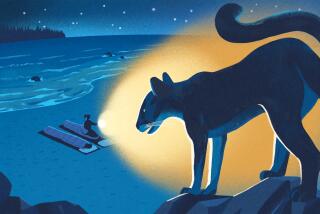What the wild things are
- Share via
Ilove this book.
Curled up in a quiet corner of the college library, I was intending to read a few pages of “The Animal Dialogues.” The next thing I knew, the day was gone, the book was done and I sat there grinning with the sweet, sad grin of someone who had just finished a delicious, exotic, omnivore’s meal.
Yes. Omnivore. For that is what we humans are: omnivorous animals. We eat everything. Plants. Animals. Look me in the eye. What do you see? An omnivorous, bipedal, mostly naked ape.
Craig Childs has been looking a lot of animals in the eye, including a naked ape or two, and “The Animal Dialogues” is his report of what he saw.
Childs is a child of the desert. He was born and raised in the dry lands of the American West and still lives off the grid between the Colorado mountains and searing sand with his wife and two sons. He is sometimes compared to that other gifted chronicler of the American West, Edward Abbey, but Childs is less cranky, more lyrical -- more the not-quite-domesticated coyote to Abbey’s rattlesnake.
I’ve admired Childs’ work in the past, but “The Animal Dialogues” drew me in more than his earlier books. I am, after all, a creature of the highly domesticated New England woodlands, with a natural resistance to parched places full of things that scratch, bite and poison, if they don’t eat you outright. In his new book, Childs describes encounters with animals as diverse as mountain lions and great blue herons, grizzly bears and swallows, some of which I have encountered myself, others of which I am just as happy to meet on the page.
And -- take a deep breath -- we surely do meet them.
As I read Childs’ description of meeting a mountain lion in the remote Blue Range Primitive Area of Arizona, the hairs were standing up on the back of my neck: “The mountain lion sizes me up and down, closing the space between us. The face says nothing, while the tail twitches like a lie detector.” And there, just a few steps from the twitching tail, Childs, scared out of his wits, is trying to project a kind of truth that will dissuade the animal from ripping him limb from limb.
This is not the sort of Frank Buck “Bring ‘em Back Alive” book I read as a boy, in which the animals are beasts to be shot or trapped. When I had finished Childs’ chapter on mountain lions, the lion was still free in the wild and I knew more about the natural history of the big cats than I ever imagined I might. He has a gift for weaving fascinating scientific fact into compelling narrative. His book is not just an adrenaline rush; it is also an education.
Big cats, yes. Sharks too, and elks and antelopes. But also rainbow trout and red-spotted toads, a praying mantis and a snowstorm of mosquitoes.
The mosquito is the smallest animal in Childs’ bestiary, and he meets them in uncountable, bloodsucking numbers while canoeing in the Alaskan wilderness. “What we are dealing with was a genius of sensory organs, a nightmare insect that will find you anywhere you hide. Of any creature this size, the mosquito has the most complex mechanical wiring known. Fifteen thousand sensory neurons reside in the antennae region alone. . . . Electron-microscope examination reveals interconnected rods and chambers, pleated dishes and prongs and plates. . . . These take the mechanical and electrical impulses to the mosquito’s brain, a brain the size of a pinprick on a piece of paper.” The big softball-sized brains of Childs and his traveling companion are no match for the combined assault of a zillion single-minded pinpricks. Here is more than you ever wanted to know about mosquitoes, and certainly enough to keep you out of the Arctic in mosquito season.
Childs’ animal encounters are not all in the wilderness. One takes place in downtown New York City. “We happened to look up and witness an event so blindingly extraordinary that most people would not see it,” he writes. I won’t tell you what he saw, but many of the encounters described by Childs are the sort that might happen to any of us. The lesson I took away is this: It is not just the animal encountered that makes the event extraordinary but also the alertness and receptivity of the encounteree. Is that a word? Well, never mind. This is a book that juices up the alertness and receptivity of even an old domesticated New Englander like me.
As I said, I had a hard time putting it down, but it’s the sort of book you can keep by your comfy chair and read the chapters in any order. Childs will convince you that, despite the soft accouterments of civilization, you are still that bipedal, omnivorous, mostly naked ape -- a flesh-and-blood part of the kingdom animalia.
--
Chet Raymo’s most recent book is “Walking Zero: Discovering Cosmic Space and Time Along the Prime Meridian.”
More to Read
Sign up for our Book Club newsletter
Get the latest news, events and more from the Los Angeles Times Book Club, and help us get L.A. reading and talking.
You may occasionally receive promotional content from the Los Angeles Times.






